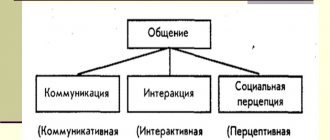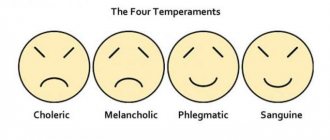The sides of communication are closely interconnected. In total, there are three aspect aspects of the communication interaction of individuals, namely communicative, perceptual and interactive. The boundaries between such sides of communication are quite symbolic and often merge, complementing each other. The aspects of communication in psychology should be considered from the perspective of joint activity and as a special activity. Communication interaction is a unique structural model containing two aspects: content and formal. The substantive aspect of interaction is reflected in the communicative function of communication, and the formal aspect in the behavioral side of communication, which is realized during the interaction.
Perceptual side of communication
The perceptual side of communication is the understanding of the human interlocutor. The process occurs at all levels accessible and understandable to humans. While people communicate, each of them tries to understand, cognize and make one question clear to themselves: who is the person opposite?
To get to know another person, the following are analyzed:
- His external data to understand the meaning of his statements.
- His emotional state, attitude to the topic, what is happening.
- His view of how he connects objects, relates to them, interprets them.
- His beliefs, attitudes, worldview, etc.
- His system of thinking, train of thought.
At least two people must participate in the process. Each of them tries to get to know the second personality in order to give themselves an answer to the main question about who is in front of them. When a person understands another, then it is easier for him to decide what to say, how to react, what to advise, how to behave, etc. However, getting to know another person takes a lot of time. This is where the brain function of thinking comes into play.
Since each person has experience of past contacts with other people, he already has some ideas about them, has noted some similarities between personalities, he can use this knowledge to supplement the missing information. In other words, a person makes an assumption about who is in front of him based on the experience that he has. Because this happens automatically, people often notice that they are making mistakes. However, the first opinion always seems to be correct, since the person has already encountered something similar, which allows him to think that this time he has encountered the same thing.
The perceptual side of communication is aimed at understanding the other person. Why is this necessary? In order to further predict your behavior. Since communication does not occur without the desire to influence the interlocutor, change his beliefs, make him a like-minded person, a person must first understand how the interlocutor thinks and what is guided by him in order to use the information received for his own benefit.
This is not good or bad. It just happens automatically, since every person wants to understand those around him in order to choose a model of communication that will be beneficial to him.
Stereotypes of perception.
- The halo effect is the tendency to judge positive character traits based on the perception of appearance. Attribution of negative properties is the anti-halo effect.
- Attitude is an unconscious desire to think in a certain way about a person or treat him under the influence of someone else’s opinion or one’s own experience.
- Causal attribution is the attribution of motives for behavior based on attitudes.
In order to get rid of stereotypes or patterns of perception, it is important to have reflection - to be able to reflect yourself.
The interactive side of communication
The purpose of any communication is to change the behavior of another person, in other words, to influence. And for this to happen, joint activity during communication is necessary. People don’t just use words to convey their thoughts, but fill them with meaning, emotions, stress, and activity. All this should influence the interlocutors, convince them and direct them in a different direction.
The interactive side of communication is often regulated by social norms, that is, etiquette and rules of decency. That is why a person, while maintaining a certain style of communication, must adhere to its rules, which help him achieve what he wants. Whether it’s business communication or an interview, each style has its own rules that show what needs to be done to achieve a particular result.
The need to adhere to certain boundaries forces people to be responsible for their own behavior. Those who do not adhere to the framework are also responsible for the results they achieve. So, each person plays a certain role according to certain rules. And each person in a given situation occupies different roles.
The causes of conflicts between people are the inability to conform to social rules, to play roles correctly, and to adhere to norms. Sometimes people conflict because they do not want to engage in the activities that are offered to them. Everyone tries to take the role of the other, and not the one that is offered to him. Each offers its own types of activities that conflict with the needs and desires of opponents.
Functions and purpose of social perception
So, the perceptual side of communication is a serious process of information exchange between people. They examine, evaluate, try to understand and accept each other. The functions of social perception include 5 points:
- Studying yourself. It is carried out through awareness of oneself through other people. By interacting socially with others, you gain information about yourself. By perceiving the personality of your interlocutor, you gain the opportunity to try on his character traits for yourself. This helps you see your own hidden desires, fears, and needs.
- Studying a partner. This function of perception includes understanding the views and beliefs of people around you. This is the only way you can get 100% accurate information about a person. There is no other way to do this. Communication is the basis of any type of relationship, be it romantic, friendly or friendly.
- Organization of joint work. If the subjects of social relations understand and accept each other, they can easily conduct joint activities. Knowing your partner’s attitudes, his motives, and values helps you behave correctly with him. In the interaction of not two people, but a group, perception is even more important. Joint activity in this case is possible only with full understanding and acceptance by one member of the team of all the others and vice versa.
- Development of mutual understanding. This perceptual function is the basis of any relationship. Common ground, common interests and views are the key to enjoying communication. It is also an opportunity to find compromise solutions in controversial situations.
- Development of emotional interaction. Any relationship evokes feelings and emotions in a person. As a result, sympathy, hostility, friendship and other types of relationships appear between people.
The communicative side of communication
The communicative side of communication is understood as the transmission and reception of information in the narrowest sense of the word. However, people usually not only convey their thoughts and ideas by speaking words, they not only send and receive (perceive) information. There are also many other aspects that occur during the communication process:
- Exchange of emotions. A person expresses his emotions through facial expressions, gestures, and intonation in his voice.
- Exchange of instructions. This is manifested in the intonation of the voice, accompanied by facial expressions and gestures.
In the process of communicative interaction, it becomes important how correctly people use words to convey their thoughts and how correctly their interlocutors understand them. Problems arise when a person incorrectly selects words that do not convey his main ideas, and also when interlocutors interpret words in a meaning other than their intended meaning.
Quite often, during communication, people try to find the hidden meaning of what was said. Under the words “What did you eat today?” many may hear “I want to control the process of your nutrition.” Although in fact the person simply inquired about the interlocutor’s eaten menu.
The problem disappears when people not only talk and listen, but also resort to various clarifications, questions, retelling, asking again, etc. All this allows them to expand the meaning of what was said, which often cannot be conveyed in one sentence. People gain greater understanding when they try to understand what they hear rather than instantly deciding what they hear.
Depending on the content
Communication is divided into the following types, depending on the purpose of the conversation and its content.
- Material – may involve the exchange of items needed for an activity. It can occur between close people, when people pass household items to each other, or, for example, in a store, while purchasing various products. In most cases, such communication serves as a way to satisfy everyday and current human needs.
- Cognitive – includes the transfer of various information. It can broaden a person’s horizons, this may include discussing various abilities and skills and sharing existing experience. In most cases it occurs in the professional sphere.
- Conditional – refers to the mental states of people. May include consoling the interlocutor and providing him with moral assistance.
- Motivational – includes motivation and motivation. It can inspire a person to take certain actions, set him various goals and encourage him to take some kind of action.
- Activity - consists of physical contact, the exchange of various actions, skills, abilities or operations.
Bottom line
From childhood, a person learns speech, which allows him to more quickly and easily convey his thoughts, objections and ideas. However, in the process of communication there are many hidden aspects that must be realized by a person in order to interact more deeply and accurately with others.
In the process of communication, it remains important to understand both the interlocutor himself and his messages that he conveyed to the person. If everything is perceived correctly, then the person will have no questions left. He will understand everything very clearly and clearly for himself, without any guesses and conjectures, which are often erroneous.
Metalanguage.
As we found out earlier, on average 60–80% of personal communication occurs through nonverbal channels, but verbal communication is also extremely important. Like body language, metalanguage is based on “intuition,” “premonition,” “sixth sense,” and the understanding that the words and thoughts of the interlocutor are not at all the same thing.
The most typical annoying metawords are “you see,” “so to speak,” “well,” and the latest masterpiece of our time, “as if.” These phrases are most common among the less educated part of society, although they are very often found in the media.
If you remove all meta-expressions from speech, then the conversation will become short, sharp and exclusively semantic. We will begin to seem rude, cruel and inconsiderate to each other. Metalanguage softens the blows we strike at each other, allows us to manipulate the other person, achieve our own goals and release emotions without causing mortal offense.
Other types
There are also several other types of communication that do not fall into the above categories. These include the following:
- Verbal is one of the main types of communication carried out through speech. Provides a person with ample opportunities, as well as the ability to express his thoughts. Can refer to both business conversations and everyday conversations.
- Nonverbal - includes communication through gestures, tactile contacts, touches and other things. For example, nod your head or wave goodbye.
- Business – refers to career growth and professional affairs. A person is trying to make a business acquaintance or successfully negotiate.
- Educational - communication through which one person tries to have a significant influence on another. An example is the process of raising a child by a parent.
- Personal communication, unlike business communication, does not belong to the professional sphere. People may be interested in each other's opinions or moods for the sake of their own goals and to maintain personal relationships. For example, you can cite friendships or family relationships.
Depending on the funds
There are several types of communication, depending on the means used by a person.
- Direct – carried out with the help of organs and parts of the body given to man by nature. For example, arms, legs, eyes or vocal cords. In this case, improvised means are not used.
- Indirect – implies communication using improvised means. For example, throw a stone, leave a mark on the ground, or pick up a stick. Also includes communication by cell phone, email, or other means of communication.
- Direct – involves personal communication between two or more people. This can include both casual conversations and physical contact.
- Indirect – represents communication through third parties. Involves negotiations, spreading rumors or transmitting some information.











